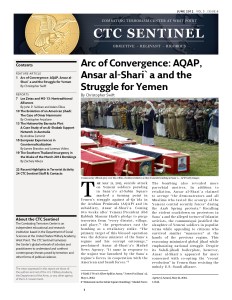Cover Story Overview
Arc of Convergence: AQAP, Ansar al-Shari`a and the Struggle for Yemen
By Christopher Swift
The May 21, 2012, suicide attack on Yemeni soldiers parading in Sana`a’s al-Sabin Square marked a turning point in Yemen’s struggle against al-Qa`ida in the Arabian Peninsula (AQAP) and its subsidiary, Ansar al-Shari`a. In addition to retaliation, Ansar al-Shari`a claimed to avenge “the demonstrators and all Muslims who tasted the scourge of the Yemeni central security forces” during the Arab Spring protests. Recalling the violent crackdown on protestors in Sana`a and the alleged torture of Islamist activists, Ansar al-Shari`a justified the slaughter of Yemeni soldiers in populist terms while appealing to citizens who survived similar “massacres” at the hands of the previous regime. This reasoning minimized global jihad while emphasizing national struggle. Despite being rooted in Yemen’s culture, society, and tribal system, the movement maintains its rhetorical and operational focus on the far enemy—underscored by the recent attempt to bomb a passenger aircraft bound for the United States. These parallel approaches could ultimately diverge, creating tensions between national objectives and international ambitions. For the moment, however, AQAP has proven remarkably adept at reconciling the ideological dictates of global jihad with the practical realities of local insurgency.
 Skip to content
Skip to content

